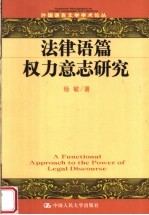图书介绍
法律语篇权力意志研究2025|PDF|Epub|mobi|kindle电子书版本百度云盘下载

- 杨敏著(中国人民大学) 著
- 出版社: 北京:中国人民大学出版社
- ISBN:9787300084015
- 出版时间:2007
- 标注页数:303页
- 文件大小:9MB
- 文件页数:322页
- 主题词:权利-法律语言学-研究;意志-法律语言学-研究
PDF下载
下载说明
法律语篇权力意志研究PDF格式电子书版下载
下载的文件为RAR压缩包。需要使用解压软件进行解压得到PDF格式图书。建议使用BT下载工具Free Download Manager进行下载,简称FDM(免费,没有广告,支持多平台)。本站资源全部打包为BT种子。所以需要使用专业的BT下载软件进行下载。如BitComet qBittorrent uTorrent等BT下载工具。迅雷目前由于本站不是热门资源。不推荐使用!后期资源热门了。安装了迅雷也可以迅雷进行下载!
(文件页数 要大于 标注页数,上中下等多册电子书除外)
注意:本站所有压缩包均有解压码: 点击下载压缩包解压工具
图书目录
Chapter One Introduction1
1.1 Rationale of the Study1
1.1.1 An Urgent Need for Discourse Analysis1
1.1.2 The Importance of Legal Discourse2
1.1.3 A Need for Research of Legislative Discourse5
1.2 Aims of the Present Study7
1.3 Research Methodology and Data Collection8
1.4 Organization of the Dissertation8
Chapter Two Literature Review11
2.1 Introduction11
2.2 Discourse Analysis(DA)12
2.2.1 The Philosophical Origins of Discourse Analysis12
2.2.2 Contributions of Linguists to DA15
2.2.3 Three Strategies of Discourse Analysis(DA)16
2.3 Critical Discourse Analysis(CDA)18
2.3.1 Introduction to CDA18
2.3.2 Three Major Issues of CDA19
2.3.3 Approaches to CDA24
2.3.4 Limitations in CDA30
2.4 A Systemic Functional Approach to DA32
2.5 Legal Discourse Analysis39
2.5.1 Studies in Legal Language-as-object39
2.5.2 Studies in Language-as-process41
2.5.3 Studies in legal language-as-instrument42
2.5.4 Current Domestic Research on Legal Discourse44
2.5.5 Analysis of Legislative Discourse of the Present Dissertation45
2.6 Summary46
Chapter Three Theoretical Framework of the Present Research47
3.1 Introduction47
3.2 Evaluation of Thompson's Methodological Framework47
3.2.1 Strengths of Thompson's Framework47
3.2.2 Limitations of Thompson's Framework52
3.3 Evaluation of the Hallidayan Model54
3.3.1 Strengths of the Hallidayan Model54
3.3.2 Limitations of SFG56
3.4 A Critical-Functional Framework56
3.5 Data Collection61
3.6 Summary63
Chapter Four The Power of Legislative Discourse in Contexts of Culture & Situation65
4.1 Introduction65
4.2 Power in Context of Culture of Legislative Discourse66
4.2.1 Concept of Context of Culture66
4.2.2 Genre66
4.2.3 Spacio-temporal Settings of Legislative Discourse68
4.2.4 Schematic Structure and Analysis of Its Ideology in Legislative Discourse72
4.2.5 The Power in Realizational Patterns77
4.3 Analysis of Situational Context84
4.3.1 Power in Fields of Interaction & Social Institutions85
4.3.2 Power in Social Structure93
4.3.3 Power in Technical Transmission Media96
4.4 Summary104
Chapter Five Power in the Ideational Function107
5.1 Introduction107
5.2 The Power of Logical Function in Legislative Discourse108
5.2.1 The Concept of Logical Function108
5.2.2 The History of the Development of Logical Progression of Statutes109
5.2.3 Analysis of Logical Structure of the Statutes111
5.2.4 Power in Logical Function of Legislative Discourse125
5.3 The Power of Experiential Function128
5.3.1 Processes in the Legislative Discourse128
5.3.2 Circumstances in Experiential Function144
5.3.3 Experiential Metaphor(Grammatical Metaphor)146
5.4 Summary148
Chapter Six Power in the Interpersonal Function151
6.1 Introduction151
6.2 The Definition of Interpersonal Function151
6.3 Modality in Legislative Discourse155
6.4 Participants in the Legislative Discourses174
6.5 Summary176
Chapter Seven Textual Function of Legislative Discourse179
7.1 Introduction179
7.2 Textual Function179
7.3 Thematic Structure in Legislative Discourse180
7.3.1 Theme Types181
7.3.2 The Pattern of Thematic Progression of Legislative Discourse192
7.4 Power in Information Structure198
7.5 Cohesion System203
7.6 Summary207
Chapter Eight Vagueness in Lexicon209
8.1 Introduction209
8.2 Vagueness in Legislative Discourse210
8.2.1 The Tension Between Vagueness and Precision210
8.2.2 Ineliminability of Vagueness215
8.2.3 Vagueness as a Defect in Legislative Discourse216
8.3 Other Characteristics of Lexicon in Legislative Discourse219
8.4 Summary221
Chapter Nine Interpretation of Legislative Discourse223
9.1 Introduction223
9.2 The Concept of"Interpretation"223
9.2.1 The Interpretation Theory of Ideology223
9.2.2 Some Critical Legal Theories on Interpretation of Power224
9.3 The Nature of Legislative Discourse227
9.4 Functions of Law229
9.4.1 Regulating Society230
9.4.2 Balancing Interests231
9.4.3 Educational Function232
9.4.4 Adjusting Economy233
9.4.5 Maintaining Historical Continuity and Consistency of Doctrine233
9.5 Analyzing the Ideology in Legislative Discourse234
9.5.1 The Sovereign Power of the State235
9.5.2 The Inequality Between Legal Professionals and Laymen236
9.5.3 The Real Inequality Behind the Superficial Equality in Legislature237
9.5.4 The Arbitrary Use of power—a tendency240
9.6 The Interactive Relationship Between Language and Power240
9.6.1 Language Has Power240
9.6.2 Power Selects Language241
9.7 Summary243
Chapter Ten Conclusion245
10.1 Major Conclusions of the Present Study245
10.2 Contributions of the Current Research249
10.3 Limitations and Suggestions for Future Research249
Appendix Ⅰ-Ⅹ253
Bibliography291
热门推荐
- 2846326.html
- 350858.html
- 441729.html
- 716536.html
- 2291090.html
- 1769783.html
- 1178908.html
- 1327039.html
- 3389476.html
- 1116762.html
- http://www.ickdjs.cc/book_1299315.html
- http://www.ickdjs.cc/book_3508204.html
- http://www.ickdjs.cc/book_3161852.html
- http://www.ickdjs.cc/book_194653.html
- http://www.ickdjs.cc/book_2100651.html
- http://www.ickdjs.cc/book_2969838.html
- http://www.ickdjs.cc/book_2575005.html
- http://www.ickdjs.cc/book_716974.html
- http://www.ickdjs.cc/book_1037978.html
- http://www.ickdjs.cc/book_1233466.html